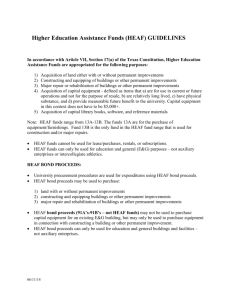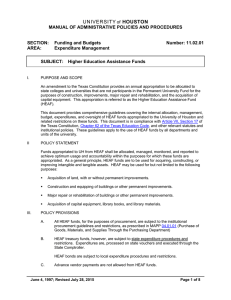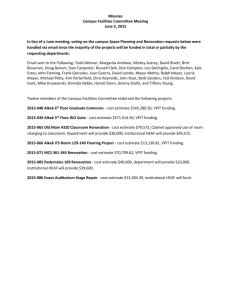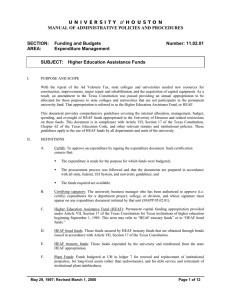Higher Education Assistance Funds (HEAF) GUIDELINES
advertisement
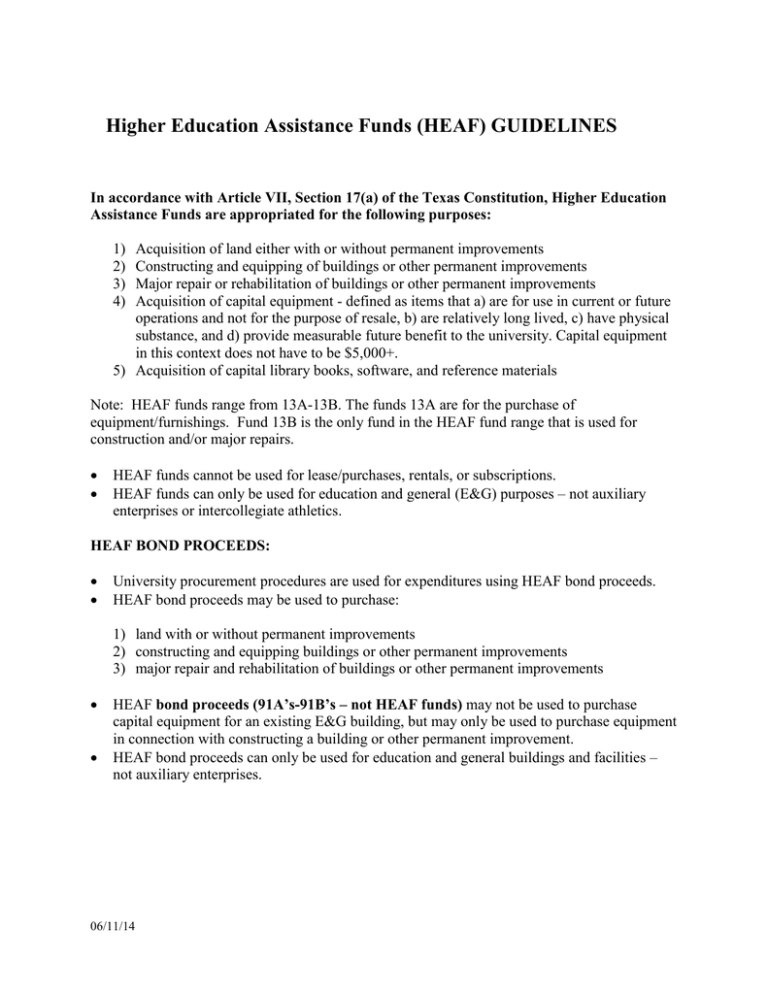
Higher Education Assistance Funds (HEAF) GUIDELINES In accordance with Article VII, Section 17(a) of the Texas Constitution, Higher Education Assistance Funds are appropriated for the following purposes: 1) 2) 3) 4) Acquisition of land either with or without permanent improvements Constructing and equipping of buildings or other permanent improvements Major repair or rehabilitation of buildings or other permanent improvements Acquisition of capital equipment - defined as items that a) are for use in current or future operations and not for the purpose of resale, b) are relatively long lived, c) have physical substance, and d) provide measurable future benefit to the university. Capital equipment in this context does not have to be $5,000+. 5) Acquisition of capital library books, software, and reference materials Note: HEAF funds range from 13A-13B. The funds 13A are for the purchase of equipment/furnishings. Fund 13B is the only fund in the HEAF fund range that is used for construction and/or major repairs. HEAF funds cannot be used for lease/purchases, rentals, or subscriptions. HEAF funds can only be used for education and general (E&G) purposes – not auxiliary enterprises or intercollegiate athletics. HEAF BOND PROCEEDS: University procurement procedures are used for expenditures using HEAF bond proceeds. HEAF bond proceeds may be used to purchase: 1) land with or without permanent improvements 2) constructing and equipping buildings or other permanent improvements 3) major repair and rehabilitation of buildings or other permanent improvements HEAF bond proceeds (91A’s-91B’s – not HEAF funds) may not be used to purchase capital equipment for an existing E&G building, but may only be used to purchase equipment in connection with constructing a building or other permanent improvement. HEAF bond proceeds can only be used for education and general buildings and facilities – not auxiliary enterprises. 06/11/14 ACCEPTABLE HEAF EXPENDITURES AND RESTRICTIONS Acquisition of land with or without permanent improvements: For the purposes of HEAF expenditures, the following definitions and guidelines apply: a. Land: The surface or crust of the earth which can be used to support structure and which may be used to grow crops, grass, shrubs, and trees. b. Cost of land may include: 1) 2) 3) 4) 5) 6) 7) 8) 9) 10) 11) Purchase price Commissions Fees for examining and recording titles Surveying Drainage costs Land clearing Demolition of existing improvements (less salvage) Landfilling Grading Interest on mortgages accrued at date of purchase Other costs incurred in acquiring the land Construction and equipping of buildings or other permanent improvements, for the purposes of these guidelines, are defined as follows: a. Constructing and equipping: The process of erecting buildings and providing equipment that will assure that the buildings can be used for the purposes intended, and the constructing and equipping of other permanent improvements. This category includes additions to and equipping of existing buildings. It does not include consumable supplies. b. Buildings: Roofed structures (conventional or underground) housing operations. This category includes storage structures and additions to buildings meeting this definition. c. Other permanent improvements: Assets that enhance the quality of land or buildings or facilitate the use of land or buildings and that have finite but extended lives. Permanency is relative and should be interpreted in terms of the periods of usefulness. Only land can be considered permanent in any absolute sense. Examples of other permanent improvements: Paving; lighting; fences; sewers; electrical distribution systems; water systems; sewer systems; landscaping; air conditioning; elevators; vent hoods; energy management systems; mechanical, plumbing, and electrical systems; voice-and-data systems; computing systems; and the like. Systems that in normal usage could be moved from building to building or from room to room are not included as permanent improvements. 06/11/14 d. Cost of buildings may include: 1) Original contract price or cost of construction; 2) Expenses for remodeling, reconditioning, or altering a purchased building to make it suitable for the purpose for which it was acquired; 3) Payment of unpaid or accrued taxes on the building to the date of purchase; 4) Cancellation or buy-out of existing leases; 5) Other costs related to placing the asset into operation. e. Construction costs of buildings and other permanent improvements can include the costs of: 1) 2) 3) 4) 5) 6) 7) 8) The completed project; Excavation, grading, or filing of land for a specific building; Preparation of plans, specifications, blueprints, etc.; Building permits; Architects’, engineers’, or management fees for design and supervision; Legal fees; Temporary buildings used during construction; Unanticipated costs such as rock blasting, piling, or relocation of channel of underground stream; 9) Drainage costs; 10) Land clearing; 11) Demolition of existing improvements; 12) Maintenance agreements purchased as part of the original acquisition (such as those for software application programs and operation systems or for energy management systems). f. Equipping costs can include costs of: 1) Original contract or invoice of the furnishings or equipment; 2) Freight-in, import duties, handling, and storage; 3) Specific in-transit insurance; 4) Sales, use, and other taxes imposed on the acquisition; 5) Site preparation; 6) Installation; 7) Testing and preparation for use; 8) Reconditioning used items when purchased; 9) Maintenance agreements purchased as part of the original acquisition; 10) Development of software application programs and operating systems. g. Unless approved in advance by the Legislature, institutions cannot use these funds for constructing and equipping buildings and other improvements for a branch campus or educational center that is not a separate degree-granting institution created by general law. 06/11/14 Major repairs or rehabilitation of buildings or other improvements can include the following categories: Repairs Renovations Replacements Improvements a. These improvements are normally expected to: 1) 2) 3) 4) 5) 6) Extend the useful life in excess of one year Improve operating efficiency Eliminate health and safety hazards Correct structural or mechanical defects Upgrade the quality of existing facilities Convert these assets to more useful functions b. HEAF funds may be used to purchase hardware and building supplies for use on “major” construction or renovation projects. This does not include projects for routine maintenance, repairs, cleaning, painting, and replacement of a part or component with a comparable part, minimal increase in life expectancy of an existing building. Qualifying HEAF projects must have a total cost exceeding $5,000, the State’s established floor for capital assets. Acquisition of capital equipment, library books, and library materials, for the purposes of HEAF expenditures, include the following definitions and guidelines: a. Capital equipment: Fixed or moveable tangible assets to be used for operations, the benefits of which extend over more than one fiscal year. These assets may be purchased from an outside vendor or constructed or developed by university employees. Computer software operating systems and application programs are considered capital equipment under this definition; routine maintenance is not an allowable HEAF expenditure. b. Equipment costs can include costs of: 1) Original contract or invoice of the furnishings or equipment 2) Freight-in, import duties, handling, and storage 3) Specific in-transit insurance 4) Sales, use, and other taxes imposed on the acquisition 5) Site preparation 6) Installation 7) Testing and preparation for use 8) Reconditioning used items when purchased 9) Maintenance agreements purchased as part of the original acquisition 10) Development costs of computer software 06/11/14 11) Equipment parts may be purchased with HEAF funds if the parts materially extend or increase the useful life of an existing piece of equipment. HEAF may also be used for the purchase of parts or accessories for incorporation into a newly purchased piece of equipment. In these cases, the purchase order description must clearly identify the purchase’s HEAF allowable purchase category, and refer to parent equipment by indicating the university’s property inventory number, the equipment serial number, and the parent equipment’s original purchase order number. c. Library: For the purposes of these guidelines, a collection of books and materials in locations approved by the university that is accessible to the general university community. d. Library book: A literary composition bound into a separate volume, generally identifiable as a separately copyrighted unit. Books should be distinguished from periodicals and journals. e. Library materials: Information sources other than books (either owned or accessed), which provide information essential to the learning process, or which enhance the quality of university library programs, including: 1) 2) 3) 4) 5) 6) 7) 8) Journals Periodicals Microforms Audiovisual media Computer-based information Manuscripts Maps Documents f. Cost of library books and library materials can include the costs of: 1) 2) 3) 4) 5) 6) Invoice price of books or library materials Freight-in, handling, and insurance Binding Electronic access Reproduction and like costs Similar costs required to put these assets in place, excluding library salaries Advance payments are not allowed from HEAF funds. HEAF funds may not be utilized for operating expenses or to purchase consumable supplies. 06/11/14
